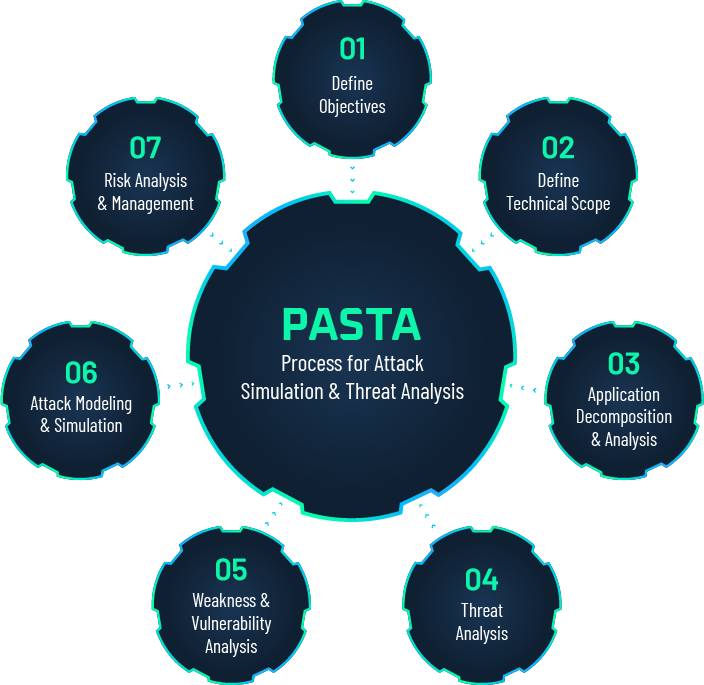A Pasta Threat Modeling Solution for Complex Cybersecurity Tasks
PASTA is not a complicated static framework. It’s an agile methodology that breaks down and solves complex cybersecurity tasks, allows scaling, and evolves with the cybersecurity landscape and business goals. VerSprite’s PASTA threat modeling solution can be customized to fit the needs of your business and protect its most important assets.
PASTA Threat Modeling Stage 1
VerSprite’s PASTA Threat Modeling Solution: Stages 1-4
PASTA (Process for Attack Simulation & Threat Analyses)splits all the software development lifecycle processes and business operations into seven cohesive stages designed to shield assets against cyber threats.

Stage 1. DEFINING OBJECTIVES:
- Defines principal business objectives of the application
- Gives an understanding of the impact of the application and functional features on the business
- Produces a risk profile for the application
Stage I helps drive governance efforts that need to be followed through security-related generalizations and a deeper understanding of their interconnectedness with business objectives.
Stage 2. DEFINING TECHNICAL SCOPE:
- Identifies all the assets in the application environment
- enumerates all software and hardware components
- Helps build a baseline of security controls aimed at reducing the attack surface for each asset
With Stage II, you achieve a clear understanding of underlying technologies and related dependencies. It helps determine potential exploits of vulnerabilities.
Stage 3. APPLICATION DECOMPOSITION AND ANALYSIS:
- Enumeration of all application use cases
- Building a clear data flow diagram (DFD) and trust boundaries
- Discovering where new security measures must be introduced
- RACI participant model to ensure the roles within the organization are clear, distributed, and assigned
Stage III helps determine where abuse cases can lead to data-focused attacks, authentication bypasses, data integrity violations, or platform persistence opportunities.
Stage 4. THREAT ANALYSIS:
- Revision of all credible diverse sources of threat data (security incidents, log and alert data)
- Cataloging likely threat agents for a given threat
- Identification of the likely threats to the application
- Attack tree development
This stage focuses on major threat targets (data, downtime, or human life) and helps identify which aspect of the application can become a potential target.
VerSprite’s PASTA Threat Modeling Solution: Stages 5-7
Stage 5. VULNERABILITY AND WEAKNESS ANALYSIS:
- Identification of weaknesses in design and architecture
- Connection of the potential threats and identified software vulnerabilities and design flaws
- Performance of targeted vulnerability testing
- Contextual risk analysis
Stage V helps strengthen application security by identifying vulnerabilities and weaknesses that are present within the application environment. By mapping them back to the attack tree, potential threats can be prioritized and remediated.
Stage 6. ATTACK MODELING AND SIMULATION:
- Gaining a better understanding of the attack surface
- Assessment of the probability and impact of the possible attack scenarios
- Testing existing countermeasures and conducting security tests centered around the contextualized risks to the application
At the heart of the risk-centric PASTA methodology, this stage allows us to perform evidence-based tests to estimate the possible impact and adjust remediation and countermeasures.
Stage 7. RESIDUAL RISK ANALYSIS AND MANAGEMENT:
- Provides calculation of risk of probable threats
- Allows establishment of reasonable risk mitigation strategies that secure business and don’t burden the budget
- Gives a clear understanding of impacts on business objectives
- Aids in maturing of the security program
This stage provides cost-effective countermeasures and recommended risk mitigation options.
Protect Your Business with VerSprite’s Cybersecurity Services
Our PASTA threat modeling solution goes beyond a security framework. It provides scalable resolutions to organizations looking to protect their data assets and applications and ensure business continuity in this turbulent cybersecurity landscape.
Being risk-centric, PASTA focuses on evidence-based threats and their probable impact on applications and organizations as a whole. It is a way to break down complex security tasks and mature the cybersecurity program to fit the needs of evolving business objectives and regulations.
For more detailed information on PASTA threat modeling, download our FREE eBook here.
Enhance your cybersecurity strategy with VerSprite’s PASTA threat modeling solution – risk-centric, comprehensive, and tailored to safeguard your digital assets.
Contact us today to safeguard your business with cybersecurity professionals.
- /
- /
- /
- /
- /
- /
- /
- /
- /
- /
- /
- /
- /
- /
- /
- /
- /
- /
- /
- /
- /
- /